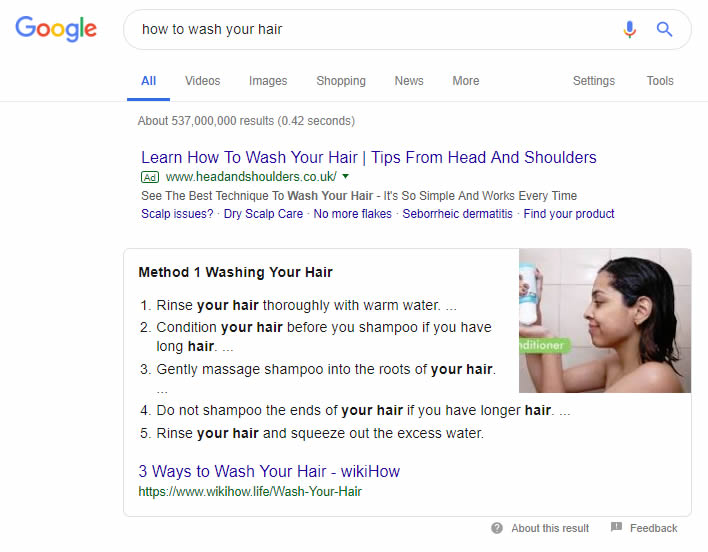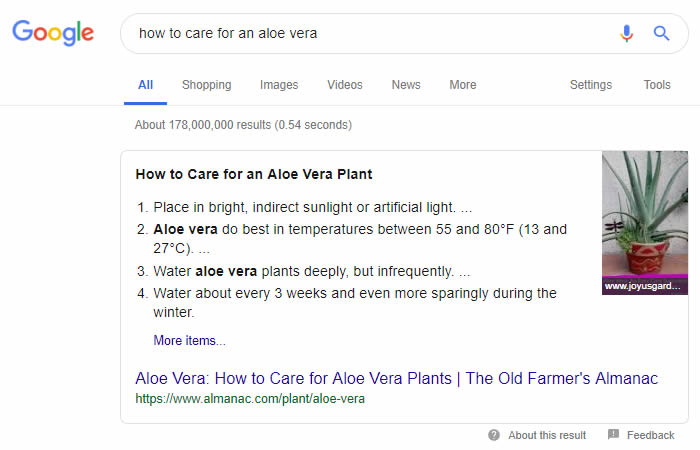
When I attended Brighton SEO last month, there was one very clear trend across all the talks I attended: featured snippets still matter and they are here to stay.
This point was clear from the opening session of the event, which was dedicated to search engine results page (SERP) features and highlighted the importance of featured snippets. Whether you like them or not, featured snippets look to be a fixture in the SERP features. Here’s why they matter and how you can win them.
What are featured snippets?
Featured what, I hear you ask? Featured snippets have also been referred to as “Google’s answer box”, and whilst both names describe a similar thing, “featured snippets” is now the preferred and generally wider-used term.
A featured snippet is the box that pops up on a SERP that answers a user’s query on the SERP page itself, rather than sending the user to another webpage. Generally, they take three forms: a paragraph with an image, a table, or a list.
For example, if you type into Google “how to wash your hair”, a list pops up at the top of the SERP, in “position zero” as it is sometimes referred to, explaining how to wash your hair in easy, numbered steps. The list is accompanied by an image and a URL to a wikiHow article about how to wash your hair.
wikiHow’s organic result on the SERP doesn’t appear until further down the page, after you’ve scrolled past a “People also ask” box, some YouTube videos and three other links, yet they still won the featured snippet on this search query.

Why are featured snippets important?
There are mixed feelings about featured snippets and their usefulness. Some content creators worry that they negatively impact click-through rates. Rand Fishkin’s article on the future of search highlights some of the issues fuelling these fears: the more information Google displays to a user on the SERP itself, the less likely they are to click on a link.
However, other content creators and marketers see featured snippets as a tool that they can use to their advantage to increase brand awareness, drive more traffic to their desired webpages and improve organic search rankings.
Take this example below for a query about how to look after an aloe vera plant. Google kindly provides a list, right there on the SERP itself. However, if I really do care about my plant, I will want to click on “More items” to ensure I’m getting the full information on how to look after my aloe vera. This helpful box is giving www.almanac.com increased exposure on the SERP, but also providing users with a strong reason to click through to their website and find out more.

The main takeaway from the talks at Brighton SEO was that winning the featured snippet for your preferred search query will increase your visibility on the SERP (brilliant for brand exposure) and will improve click-through rates.
One study by Ben Goodsell, an author at Search Engine Land, found that the click-through rate on a page increased from 2% to 8% once it was displayed as a featured snippet.
And Emily Potter from Distilled conducted an extensive study with over 3,000 data points, evaluating the impact of featured snippets on click-through rates and concluded that featured snippets improved click-through rates for every organic position.
And whilst it’s not confirmed if Google takes click-through rates into account as a ranking factor, Izzi Smith from Sixt highlighted that “you should be improving it anyway”.
How to win featured snippets
So, now we know they’re worth fighting for, how do you optimise your content for featured snippets and reach the coveted “position zero”?
1. Find out which queries you already rank for
We have already demonstrated that you don’t need to appear in position one or two to win the snippet. In her presentation at Brighton SEO, Emily Potter showed that although positions one to four are the most likely to own them, you can organically rank up to position number ten and still win the snippet.
However, positions 11+ have low chances of featuring as a snippet, so only optimise your content for the search queries where you already rank. Tools like Google Keyword Planner, SEMrush and Ahrefs can help you find which queries you already rank for (if you need a little support, we can help with this too).
2. Optimise your content’s format
Once you’ve found your set of key search queries, the next step is to make sure the content on your page is optimised:
- Are you telling users how to do something? Put it in a list.
- Do you have content that are costs or pricing brackets? Put it in a HTML table.
- Make sure your images are relevant and compressed.
- Be sure to bulk-out lists with more steps so Google will display “find out more” at the end of your list, to drive clicks to your page.
These formatting quick tips all help towards winning that snippet.
3. Optimise your header
Emily also advises to look at pages where you rank higher than the current owner of the featured snippet. Look at their content versus yours. Does your headline match the search query you’re going after? Edit your headline so it is as close to the search query as possible, and monitor any changes on the SERP and in rankings thereafter.
However, always be honest about your content. If your headline is misleading, you risk high bounce rates and losing any featured snippet you may have temporarily owned. This can also negatively impact your organic rankings in the longer term.
4. Be very aware of the user’s intent
User experience and user intent have been top of Google’s ranking factors since its core algorithm update in March 2018, so it’s important to make sure your content always answers the user’s intent. If you’re trying to win a particular search query, put yourself in the user’s shoes and make sure you are giving them information that is useful, relevant and interesting.
The best kind of intents you can optimise for are those that cross research and transactional intents, e.g. the query “best make-up for acne-prone skin”. If users are looking to compare products or services, this is the perfect scenario in which some of your content can appear in a snippet, leading them to click on to your article which will then provide them with the information they are looking for.
One area that doesn’t work so well for featured snippets is pure answer intent. If a user searches “how old is Tom Cruise”, it will be very easy for them to get the answer to that question on the SERP, without needing any additional content, so don’t waste time optimising for these kinds of queries. Always ask yourself if the query can be answered in the SERP without any additional information. If yes, don’t bother with it.
5. Don’t forget about optimisation in other languages
If you’re targeting other countries and languages with your content, you can still win the featured snippet on the SERP of your preferred language. However, there are a few extra rules to bear in mind when going international:
- Always do fresh keyword research in the language you’re targeting. Do not translate keywords as they won’t be localised and may not be relevant to your target audience.
- Get a native speaker to check your content and make sure the text not only reads well in the language you’re optimising for, but also takes into account local nuances that a non-native might not pick up on.
- Remember that translation is different from localisation; a British audience will interact differently from an American audience, and a Spanish audience will search differently from a Mexican audience. Do you research about your target audience, then optimise your content to their needs.
Conclusion
Featured snippets may seem like a lot of effort to optimise for, but the rewards can be great. If you win a featured snippet, you can see increases in click-through rates, and this can positively impact your organic ranking on the SERP. But most of all, trying to win featured snippets instills good SEO habits when you’re creating content in the future.
Here at Webcertain, we’ve been successfully optimising for featured snippets across a range of industries, so if you’d like some help with yours, just get in touch!






